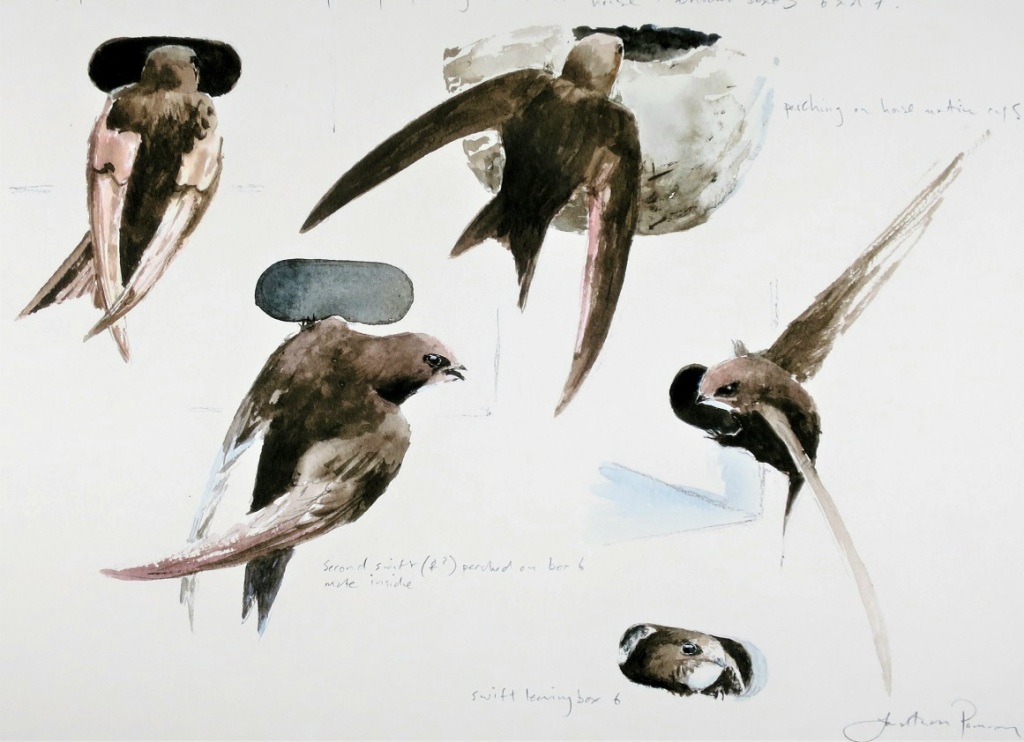Swift blog
Thankfully a lot has changed since my last blog. We are still well short of where we should be in the last third of June but we have had some hopeful signs for future years. When I last wrote we had a pair incubating two eggs (having lost their first clutch to a tree sparrow) and a single female trying to attract a mate.
Our single female swift has in the last week found a mate! Previous blogs tell her full story but having arrived on the 20th May she does seem to have formed a strong bond with a younger male swift. There is a possibility that she will breed this year but we’ll just have to wait and see. If so we may still have swifts here in late August.
Also since the last blog a new swift has arrived in box 1- it appears in the box intermittently through the day but doesn’t roost. This was the first box used here. 2023 saw the box abandoned as that pair split and took mates in boxes 2 and 3. As I type the new bird is attempting to lure a mate into box 1.
So we have five swifts associated with the house now which at least offers hope that our breeding numbers may recover to 2022 levels next year.
Leaving concerns and anxiety aside though the transition to warmer weather from 16th June has given me an opportunity to see and sketch swifts in their full glory! We’ve had mornings when prospectors have piled around the eaves crossing each others’ flight paths and the flight paths of the six pairs of house martins coming and going to their nests- it is difficult to know where to look! We’ve seen numerous fast, low passes where the sound of the air being sliced by their wings is easily audible. I’ve had views of swifts perched on walls, artificial house martin nests and swift box entrances, giving me a chance to study and paint their rich sepia plumage. I’ve watched them feeding at high altitude, only visible with the aid of binoculars and seen the first sky roosting flocks ascend at dusk.
Soak up every moment of watching swifts. We are well over half way through the main swift season now. Enjoy every fly past!
House martin blog
As previously mentioned, house martins go from strength to strength here. In fact we have since gained another pair, pair number six. They have chosen a nest box by our bedroom window so we are woken to the sound of house martin song.
This pair is the third that has chosen a nest box next to a window. Our eaves are narrow so having a side entrance or turning the nest cup 90° to the wall works well here and offers us superb views from inside the house.

The house martins give us continuous pleasure through the summer and they are here for nearly twice the duration of swifts. When the skies fall silent of swift calls in early August the house martins stay for another six weeks or so. House martins’ flight is spectacular especially now as they swoop in with food for their chicks in graceful arcs, often from great height.
The airspace above the house can be frantic with ten or so house martins mingling with up to eight swifts. At times they all just circle above, it’s mesmerising and beautiful to watch.
All text and images copyright Jonathan Pomroy 2024.

For online shop please see link https://jonathanpomroy.bigcartel.com/

Fascinating and informative as ever Jonathan and I’m glade too read of some hopeful signs too. Matt
All fascinating. Here in Marske in Swaledale there have been just 2 active swift nests for the last few years. We put up 2 swift boxes in 2021, hoping to help the colony increase, but so far we haven’t had evidence of birds investigating them. There have been just 5 swifts in the village since they arrived a few weeks ago, but suddenly this evening the number has increased to 10!. They are very excited, flying around, through our garden and past our house screaming. Where have these new arrivals come from I wonder? Why now?
You are seeing the arrival (we think!) of the second calendar year birds. Born last year they typically arrive in the last third of June. Incredibly in 20,21,22 they arrived on 23rd June in each year here. These birds will be searching for a colony to join, then a nest site especially as two year olds (next year). Enjoy them, spectacular show here too! Jonathan